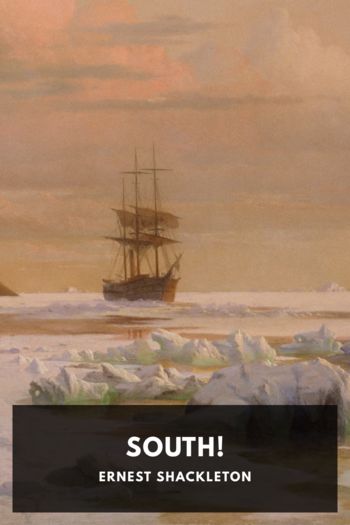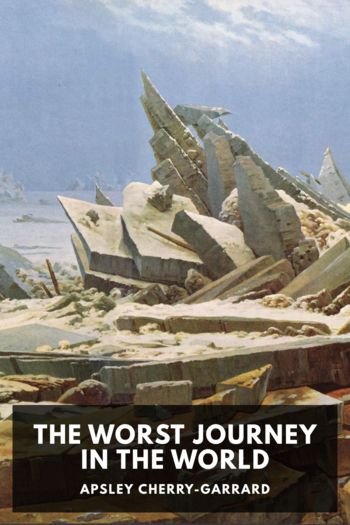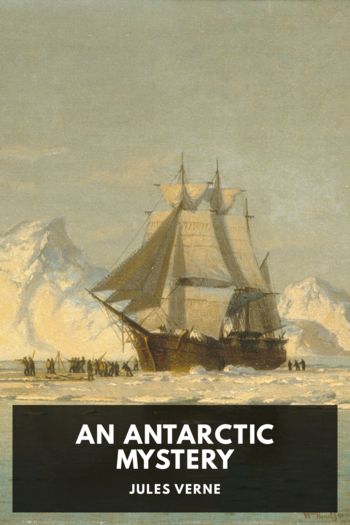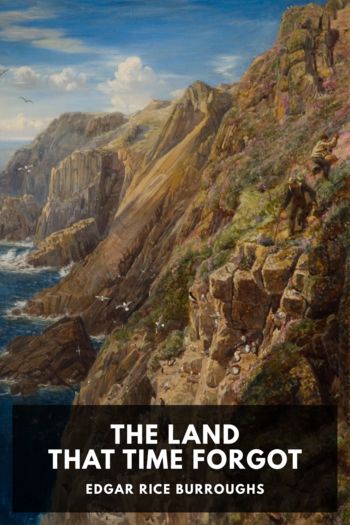South!, Ernest Shackleton [good books to read in english TXT] 📗

- Author: Ernest Shackleton
Book online «South!, Ernest Shackleton [good books to read in english TXT] 📗». Author Ernest Shackleton
Our last night on the solid ground of Elephant Island was cold and uncomfortable. We turned out at dawn and had breakfast. Then we launched the Stancomb Wills and loaded her with stores, gear, and ballast, which would be transferred to the James Caird when the heavier boat had been launched. The ballast consisted of bags made from blankets and filled with sand, making a total weight of about 1,000 lbs. In addition we had gathered a number of round boulders and about 250 lbs. of ice, which would supplement our two casks of water.
The stores taken in the James Caird, which would last six men for one month, were as follows:
30 boxes of matches.
6½ gallons paraffin.
1 tin methylated spirit.
10 boxes of flamers.
1 box of blue lights.
2 Primus stoves with spare parts and prickers.
1 Nansen aluminium cooker.
6 sleeping-bags.
A few spare socks.
A few candles and some blubber-oil in an oil-bag.
Food:
3 cases sledging rations = 300 rations.
2 cases nut food = 200 rations.
2 cases biscuits = 600 biscuits.
1 case lump sugar.
30 packets of Trumilk.
1 tin of Bovril cubes.
1 tin of Cerebos salt.
36 gallons of water.
250 lbs. of ice.
Instruments:
Sextant.
Sea-anchor.
Binoculars.
Charts.
Prismatic compass.
Aneroid.
The swell was slight when the Stancomb Wills was launched and the boat got under way without any difficulty; but half an hour later, when we were pulling down the James Caird, the swell increased suddenly. Apparently the movement of the ice outside had made an opening and allowed the sea to run in without being blanketed by the line of pack. The swell made things difficult. Many of us got wet to the waist while dragging the boat out—a serious matter in that climate. When the James Caird was afloat in the surf she nearly capsized among the rocks before we could get her clear, and Vincent and the carpenter, who were on the deck, were thrown into the water. This was really bad luck, for the two men would have small chance of drying their clothes after we had got under way. Hurley, who had the eye of the professional photographer for “incidents,” secured a picture of the upset, and I firmly believe that he would have liked the two unfortunate men to remain in the water until he could get a “snap” at close quarters; but we hauled them out immediately, regardless of his feelings.
The James Caird was soon clear of the breakers. We used all the available ropes as a long painter to prevent her drifting away to the northeast, and then the Stancomb Wills came alongside, transferred her load, and went back to the shore for more. As she was being beached this time the sea took her stern and half filled her with water. She had to be turned over and emptied before the return journey could be made. Every member of the crew of the Stancomb Wills was wet to the skin. The water-casks were towed behind the Stancomb Wills on this second journey, and the swell, which was increasing rapidly, drove the boat on to the rocks, where one of the casks was slightly stove in. This accident proved later to be a serious one, since some seawater had entered the cask and the contents were now brackish.
By midday the James Caird was ready for the voyage. Vincent and the carpenter had secured some dry clothes by exchange with members of the shore party (I heard afterwards that it was a full fortnight before the soaked garments were finally dried), and the boat’s crew was standing by waiting for the order to cast off. A moderate westerly breeze was blowing. I went ashore in the Stancomb Wills and had a last word with Wild, who was remaining in full command, with directions as to his course of action in the event of our failure to bring relief, but I practically left the whole situation and scope of action and decision to his own judgment, secure in the knowledge that he would act wisely. I told him that I trusted the party to him and said goodbye to the men. Then we pushed off for the last time, and within a few minutes I was aboard the James Caird. The crew of the Stancomb Wills shook hands with us as the boats bumped together and offered us the last good wishes. Then, setting our jib, we cut the painter and moved away to the northeast. The men who were staying behind made a pathetic little group on the beach, with the grim heights of the island behind them and the sea seething at their feet, but they waved to us and gave three hearty cheers. There was hope in their hearts and they trusted us to bring the help that they needed.
I had all sails set, and the James Caird quickly dipped the beach and its line of dark figures. The westerly wind took us rapidly to the line of pack, and as we entered it I stood up with my arm around the mast, directing the steering, so as to avoid the great lumps of ice that were flung about in the heave of the sea. The pack thickened and we were forced to turn almost due east, running before the wind towards a gap I had seen in the morning from the high ground. I could not see the gap now, but we had come out on its bearing and I was prepared to find that it had been influenced by the easterly drift. At four o’clock in the afternoon we found the channel, much narrower than it had seemed in the morning but still navigable. Dropping sail, we rowed through without touching the ice anywhere, and by 5:30 p.m. we were clear of the pack with open water before us. We passed one more piece of ice





Comments (0)